About Taiko
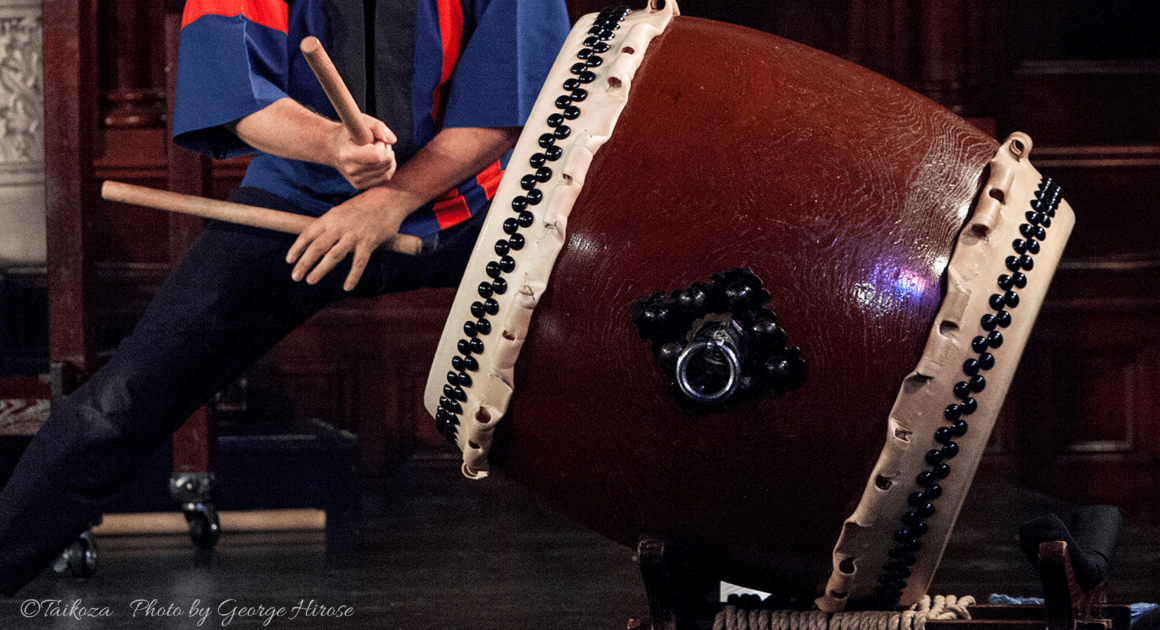
Taiko is Japan’s traditional percussion instrument
If one can envision a wide variety and multitude of drums closely assembled and beating in metrical unison, then one inevitably hears the energetic sounds of the taiko drums performed – as these powerful percussive instruments are not only prominent in the United States but duly revered and respected across the globe at large.
Over and above its universal appeal, the taiko origins embody a unique cultural and historical specificity to the extent that the taiko played and plays an essential role in classical performing-arts touchstones such as the “Noh” (能) and “kabuki” (歌舞伎) theater, the folk performing arts, conventional Japanese festivals, and sacred religious ceremonies. It is in this sense and tradition that taiko is said to be an instrument which aptly captures the Japanese spirit and culture.
History
The history of drums dates back several centuries, as evidenced in some such drums being excavated from ancient ruins. During the 5th century, various musical mediums migrated to Japan from China and Korea, where numerous types of percussive instruments were incorporated in an orchestra ensemble called “Gagaku” (雅楽), the early embodiment of Japanese court music.
Drums were also used in the music for dance theaters called “Noh” (能), which appeared during the 14th century. Noh theater uses a flute called “nohkan” (能管), along with the percussion instruments: “ō-tsuzumi” (大鼓), “ko-tsuzumi” (小鼓), and “shime-daiko” (締太鼓). These four, instruments in Noh are referred to as “shibyoshi” (四拍子).
During the 16th century, theater and dance troupes called “kabuki” (歌舞伎) became popular. Various types of drums were used in kabuki. Shibyoshi (Noh theater’s four instruments as stated above) were also incorporated into kabuki. These percussive instruments had a vital role in highlighting and revitalizing the shamisen music in “nagauta” (長唄), which subsequently developed as a form of Japanese classical music in kabuki theater. Furthermore, flutes and percussive type of instruments used to accent loud acoustic sounds came to be known as “ohayashi” (お囃子).
In modern times, there are numerous live taiko performative ensembles commonly referred to as “kumi-daiko” (組太鼓). This style of large communal performance represents the current mainstream drum performance showcase.
In addition, taiko drums play an indispensable role in Japan’s seasonal festivals, “min’yō” (民謡) folk songs, and all forms of folk art throughout the country. Since ancient times, these percussive drums played a significant role in religious ceremonies at shrines and temples, and continue to be used today to commemorate national cultural events.
Types of Taiko
The construction of taiko is made by stretching cow skin on both sides of a wooden body. The two wooden drum sticks called “bachi” (ばち), strikes both sides of the drumhead to create a sound. There are numerous types of taiko drums. Listed below are some of the more representative types of taiko.
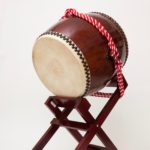 Nagadō-daiko(長胴太鼓)/ Miya-daiko(宮太鼓)
Nagadō-daiko(長胴太鼓)/ Miya-daiko(宮太鼓)
One of the most widely used taiko drums is the “nagadō-daiko” (長胴太鼓), or “barrel body-drum” seen in most drum ensembles. This drum is also referred under its alias name, “miya-daiko (宮太鼓), when used at festivals, shrines, temples and in “ohayashi” (お囃子), the musical accompaniment for the Japanese theater. Nagadō-daiko is made from wood that has been cut into round slices and carved out by hand. It is made from a single piece of wood and a single piece of leather that is fastened with “byō” (鋲/びょう), metal studs.
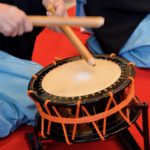 Shime-daiko(締太鼓)
Shime-daiko(締太鼓)
“Shime-daiko” (締太鼓) is a drum with a hollow body carved out by hand. It has iron rings attached to its drum head and fastened with rope or bolt. The sound quality and pitch can be adjusted with the thickness of the drum skin and the degree of tightening the rope or bolt. When shime-daiko is performed in a drum ensemble, it is often times tightened with ropes, bolts or turnbuckles. In contrast, shime-daiko used in ohayashi ensembles for Noh or kabuki theater uses twine to prevent too much tightening.
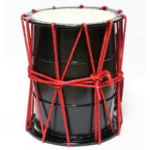 Okedō-daiko(桶胴太鼓)
Okedō-daiko(桶胴太鼓)
“Okedō-daiko” (桶胴太鼓) is a drum made out of vertically narrow lengths of wood with a slightly beveled edge to form its torso. Animal skin is stretched over the torso and tightened with a rope. Okedō-daiko is relatively light, making it a versatile instrument to be played upright, horizontally, lying sideways on the ground or slung over the shoulders.
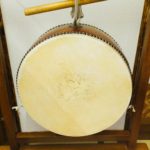 Hira-daiko(平太鼓)
Hira-daiko(平太鼓)
“Hira-daiko” (平太鼓) is a flat drum with a similar structure to the nagadō-daiko but with a short and flat torso compared to the barrel body-drum. It has a deep bass tone without the long sustain of the barrel body-drum. Hira-daiko is used in ohayashi ensembles for kabuki theater and in “min’yō” (民謡) folk songs.
Types of Tsuzumi
“Tsuzumi” (鼓) are percussive instruments that make sound by tapping them with one’s hands instead of using the “bachi” (ばち) drumsticks. There are two types of tsuzumi: small and large tsuzumi.
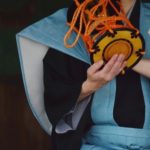 Ko-tsuzumi(小鼓)
Ko-tsuzumi(小鼓)
“Ko-tsuzumi” (小鼓) is a small, hour-glass shaped drum with horsehide stretched over the two drum heads, roped together by a cord called “shirabeo” (調緒). The performer holds the ko-tsuzumi with the left hand and places it on the right shoulder. The mechanism of the cords allows the player to raise or lower the pitch tone by tightening and loosening the grip on the shirabeo cord, which increases or decreases the tension of the drum heads respectively.
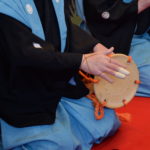 Ō-tsuzumi(大鼓)
Ō-tsuzumi(大鼓)
“Ō-tsuzumi” (大鼓), the “large tsuzumi” shares the same shape as the ko-tsuzumi, but it islarger in diameter and produces a penetrating high-pitched striking sound. Theperformer holdsthe shirabeo with the left hand and places it on the leftknee. Sound is produced by striking thedrum head with the central fingers of the right hand, which are sometimes covered with hard paper-thimbles called “yubikawa” (指皮).
Resources
Discover additional information about the Taiko below



